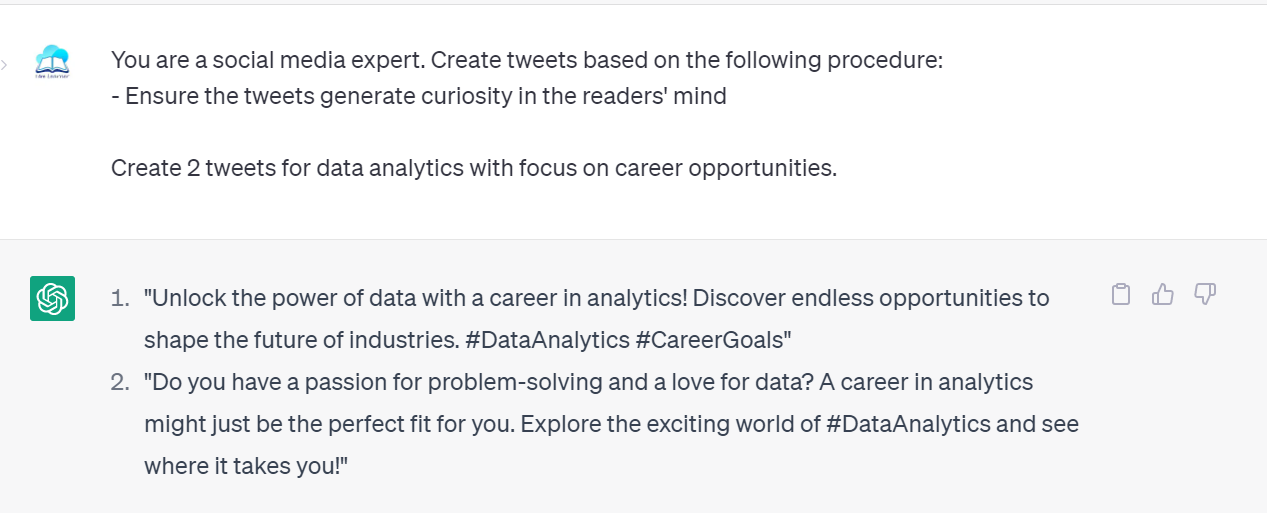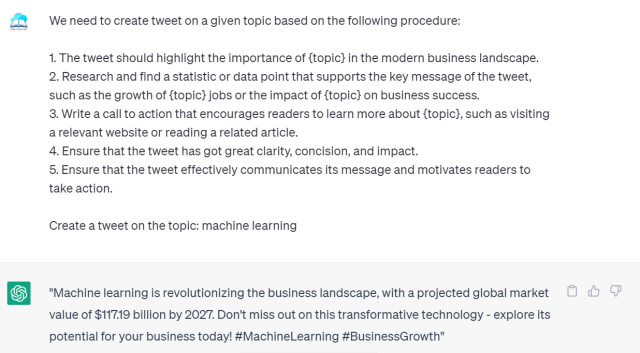
Are you looking to unlock the full potential of ChatGPT? Do you want to learn how to design & create engaging and effective prompts that can help you generate high-quality responses? Look no further! In this blog, we’ll share some expert tips and examples on how to design ChatGPT prompts that get the most out of this powerful language model.
As one of the most advanced large language models available today, ChatGPT has the ability to generate informative and engaging responses. But the key is to provide clear instructions and ask right questions if we want to get the best results. That’s where prompt design & engineering comes in. By using effective prompts, we can help ChatGPT better understand about our needs and provide more accurate and useful responses.
Whether you’re using ChatGPT for business, education, or personal purposes, some of the tips and examples listed in this blog will help you create prompts that are clear, concise, and effective. I will share expert prompts design tips and examples on how to create effective ChatGPT prompts that fulfills your requirements. So, let’s dive in and discover the power of ChatGPT prompt design together!
ChatGPT Prompts Design Tips
When it comes to designing effective prompts for ChatGPT, there are a number of tips and tricks to keep in mind. From using clear and concise language to focusing on specific topics, there are many strategies you can use to help ChatGPT generate high-quality responses. Here is a list of tips you would want to keep in mind when designing prompts:
Give Clearer Instructions – Show & Tell
One of the most important aspects of designing effective prompts for ChatGPT is to ensure that your instructions are clear and easy to understand. This means using simple and concise language, avoiding jargon or technical terms that might be confusing for the model, and providing specific examples or scenarios to help the model better understand what you’re asking for. By giving clear instructions, you can help ChatGPT generate more accurate and relevant responses.
When designing a prompt, three key elements should be considered: role, context, and task.
- Role: Assign the ChatGPT model a specific role, such as a social media expert, blogger, nutrition expert, data scientists, etc.
- Context: Provide detailed information about the situation to guide the model’s thinking and generate more specific responses.
- Task: Clearly define the desired outcome and provide sufficient information to guide the model towards achieving that outcome.
Lets understand this with an example. Lets say we want to create tweets related to data analytics.
The following can be one prompt design mentioning one instruction. In the following prompt, the role is “You are a social media expert”. The task is “Create tweets….”. You can provide context before giving task such as “I would like to create tweets for marketing my product X”.
You are a social media expert. Create tweets based on the following procedure:
– Ensure the tweets generate curiosity in the readers’ mind
Create 2 tweets for data analytics with focus on career opportunities.
The above prompt results in the following tweet:

Lets go ahead and add further instructions to make it more interesting.
You are a social media expert. Create tweets based on the following procedure:
– Ensure the tweets generate curiosity in the readers’ mind
– Provide data or statistics wherever possible
– Provide quotes wherever possible
Create 2 tweets for data analytics with focus on career opportunities.
The following would be output from ChatGPT. Make a note of statistics included in the output. Make sure to confirm the statistics from Internet, however.

If we want ChatGPT to perform a specific task while matching our expectations, we will need to provide clear instructions and / or examples to help the ChatGPT model understand the request in a nice manner. For example, asking for a list to be ranked in alphabetical order, classifying a paragraph by sentiment, or any other specific task. By providing clear guidance, you can help ensure that ChatGPT provides you with accurate and useful responses.
Break down Complex Tasks into Simpler Subtasks; Structure your instructions
Along with clear instructions, it’s also important to structure your prompts in a way that makes it easy for the model to understand what you’re looking for. This can be greatly achieved by breaking down complex tasks into smaller subtasks. This allows the model more time and space to think about each subtask, ensuring that it remains focused and can generate more accurate and relevant responses. For example, if you’re asking ChatGPT to write a product description, you might break it down into subtasks like “describe the product’s features,” “highlight its benefits,” and “provide usage instructions.” By breaking down complex tasks into simpler subtasks, you can help ChatGPT generate more detailed and relevant responses.
Here is an example of a complex instruction and how you could break the instruction in smaller task and achieve great result.
Create a tweet on data analytics that generates curiosity in the readers mind.
The output of above tweet will be the following. Note that we may not be able to use this prompt time and again.

Now, lets break the task into smaller task using this prompt. Note that this tweet can be reused by changing the “topic”
We need to create tweet on a given topic based on the following procedure:
1. The tweet should highlight the importance of {topic} in the modern business landscape.
2. Research and find a statistic or data point that supports the key message of the tweet, such as the growth of {topic} jobs or the impact of {topic} on business success.
3. Write a call to action that encourages readers to learn more about {topic}, such as visiting a relevant website or reading a related article.
4. Ensure that the tweet has got great clarity, concision, and impact.
5. Ensure that the tweet effectively communicates its message and motivates readers to take action.
Create a tweet on the topic: machine learning
This is how the output would look like:

Ask the ChatGPT to explain before answering
Another useful tip for designing effective prompts is to ask ChatGPT to explain its reasoning before giving an answer. This can help improve the reliability of the model and improve its overall performance. By asking ChatGPT to explain how it arrived at a particular answer, you can better assess the reasoning used by the model and identify areas where it might be making errors or assumptions. This can help you refine your prompts and improve the quality of the responses generated by ChatGPT.
Technically, there are different ways in which one can ask ChatGPT to provide reasons before arriving at the final answer. They are the following:
- Zero shot method (zero example method): In zero-shot method, you ask the question and end the prompt with “Let’s think step by step“.
- Few shot method (few examples method): In few shot method, the ChatGPT is prompted to reason out its answers by demonstrating with few examples (few shots).
Consider generating multiple outputs for your prompts
When executing prompts for ChatGPT, it’s often helpful to generate multiple outputs and then pick the one that looks best. This can help you identify any inconsistencies or errors in the responses generated by the model, and ensure that you’re getting the most accurate and relevant information possible. By generating multiple outputs and comparing them, you can refine your prompts and improve the quality of the responses generated by ChatGPT.
Bing Chat / ChatGPT Best Practices for Prompts Design
Microsoft recently published an article, The art of the prompt: How to get the best out of generative AI , where they listed out the best practices for prompts which can provide you with desired output. Here is the list:
- Provide detailed information in your prompts, especially for images, by including specific attributes like style, point of view, and lighting.
- Choose the appropriate mode of Bing Chat depending on whether you’re looking for creative or factual answers.
- Creative mode: Use this mode when you want imaginative or creative responses, such as stories, jokes, or poems. The AI model in this mode will generate more novel and diverse responses, often taking more risks and being less constrained by factual accuracy or practicality.
- Precise mode: Use this mode when you want factual or accurate answers, such as definitions, dates, or statistics. The AI model in this mode will prioritize accuracy and relevance over creativity, generating succinct and fact-based responses that are grounded in source material from the web.
- Balanced mode: This is the default mode in Bing Chat and works well for most scenarios, striking a balance between imaginative and factual answers. The AI model in this mode will generate responses that are both creative and accurate, depending on the prompt and the context. It’s a good starting point if you’re not sure which mode to use.
- Fact-check the responses generated by the model using the “more precise” conversation style, reading the references carefully, and framing your prompts as specific questions.
- Adjust the voice and level of understanding of Bing Chat to suit your needs when explaining a topic in a simple or technical way. For example, if you’re explaining a complex topic to someone who is unfamiliar with it, you might want Bing Chat to provide a simple explanation using everyday language, similar to how you would explain it to an 8th grader. On the other hand, if you’re discussing the same topic with an expert in the field, you might want Bing Chat to provide a more technical explanation that uses the appropriate jargon and level of detail.
- Use the “New topic” button in Bing Chat to switch topics and give the model a fresh start.
- You can specify the length of the response you want from the model, and prompt it to generate more text if necessary.
- AI-powered Bing can present data and information in different formats such as tables, diagrams, and flow charts to help users better understand complex data.
- Specify the programming language you want to use, include relevant contextual information, and test your code if necessary when using Copilot.
- Experiment with your prompts if the initial results aren’t what you want. Prompt the model again, try different tones and voices, and practice guiding the model to the results you desire.
Important White Papers to Read
You would want to check the following three white papers to learn inner details about prompts design and engineering:
- Large Language Models are Zero-Shot Reasoners
- Language Models Perform Reasoning via Chain of Thought
- Selection-Inference: Exploiting Large Language Models for Interpretable Logical Reasoning
I would continue updating this blog in the coming weeks to make it as a cookbook to design and execute prompts that work! Stay tuned!
- Mathematics Topics for Machine Learning Beginners - July 6, 2025
- Questions to Ask When Thinking Like a Product Leader - July 3, 2025
- Three Approaches to Creating AI Agents: Code Examples - June 27, 2025
I found it very helpful. However the differences are not too understandable for me